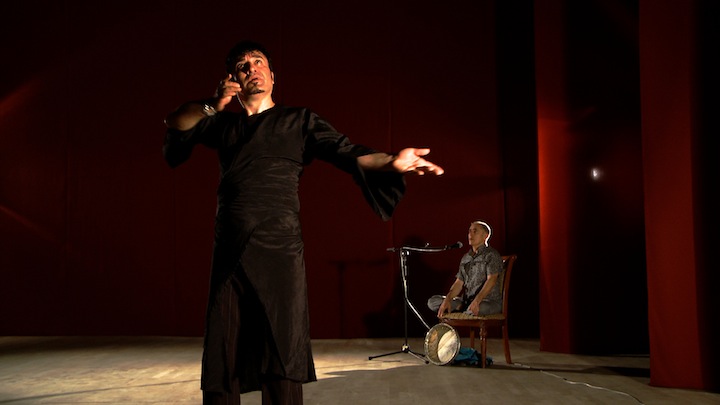
Despite humankind’s best efforts, including the recent quiet death of the Kyoto Protocol, the world will not end on Friday. But we could use Christmas overload and the flip of a Mayan calendar page as an excuse to try something new.
- Classical Music 101: What Does A Conductor Do? - June 17, 2019
- Classical Music 101 | What Does Period Instrument Mean? - May 6, 2019
- CLASSICAL MUSIC 101 | What Does It Mean To Be In Tune? - April 23, 2019
On Friday, the world’s best-known advocate of Azeri music, Alim Qasimov, teams up with Toronto dancer Sashar Zarif in a music and dance programme built on mugam, the folk music of Azerbaijan, at the George Weston Recital Hall.
It is an opportunity to let go on several different levels.
I had an chance to attend a short rehearsal on Monday afternoon. I watched Qasimov, perched cross-legged on a regular chair, singing in his clear, distinctive, piercing voice.
Placed diagonally across from him were four musicians representing the main instrument families of Azerbaijan (similar to those from the Persian tradition): tar (lute), balaban (oboe), kamancheh (lap violin) and daf (drum). Qasimov was in constant communication with them, like a conductor, but each of the players also took turns leading the quartet — much like a jazz combo.
Between singer and instrumentalists moved Zarif, at times directly responding to the rhythms of the music — at others spinning away into an ecstatic state.
I sat there watching, looking for structure in these actions and interactions. I tried to find rhythmic patterns and listened for modal shifts. I wondered what Qasimov was singing.
And then, at the end of an interview following the rehearsal, came a gentle admonition in the form of a riddle from Qasimov via Zarif, who acted as translator:
“Western audiences are always looking for translations,” said Qasimov. “But we are not singing the words. You need to listen to the feeling.”
Zarif quoted the poet Rumi to underline the point: “The science of our love is not in the books.”
In other words, my job was not to analyze or dissect or to seek rational understanding. My job was to walk through the door with an open mind and open heart.
“The audience should come knowing where they’re going,” Quasimov said. “But when they get there, they need to take a seat and surrender to the experience of the moment. It’s up to us to take them on a journey.”
It’s like that trust exercise where a person falls backwards into the steadying arms of a group of peers — an exercise that could benefit many a Western classical music performer and audience member.
This level of trust extends to the performers themselves. I asked Qasimov how he chooses and works with instrumentalists who need to be able follow as well as lead in a spirit that involves a lot of improvising. He answered that it’s not the technical skills of a musician that matter, but their ability to connect with each other and their listeners on an intuitive, purely emotional level.
“The technique can come later,” Qasimov added.
One thing that makes Friday’s performance special even for those people who are already familiar with Azeri music is the incorporation of dance.
Qasimov explained that dance was once a part of mugam — much in the way that it is integral to sufi practice — but has, over the centuries, disappeared. Performances like this one are attempts to see how the disciplines can be reunited.
I asked why they have chosen Winter Solstice as the night.
“It’s an important night. In Azeri culture, it marks the birth of the sun, when days start getting longer,” replied Zarif.
Qasimov, who can look pretty severe when not singing, smiled broadly. “Every day is Winter Solstice.”
+++
For details on Friday’s event, titled Sama-e Rast, click here. There is a gallery exhibit that opens at 7 p.m., an hour before the show. There is also a post-show screening of a documentary.
+++
If you would like to know more about Azeri folk music, there is a thorough, reasonably well-translated study available online, originally published in 1944 by Azeri composer and musicologist Uzeyir Hajibeyli: Principles of Azerbaijan Folk Music.
Haajibeyli explains the seven basic modes, which work differently from Western modes or scales. He doesn’t use the term mugam, mainly because ethnic music of any sort wasn’t officially encouraged in the former Soviet Union.
There’s a thriving culture in Baku, Azerbaijan’s rapidly modernizing capital, devoted to the growth and dissemination of mugam. One of its online ambassadors is Mugam Radio, available here.
John Terauds
- Classical Music 101: What Does A Conductor Do? - June 17, 2019
- Classical Music 101 | What Does Period Instrument Mean? - May 6, 2019
- CLASSICAL MUSIC 101 | What Does It Mean To Be In Tune? - April 23, 2019



